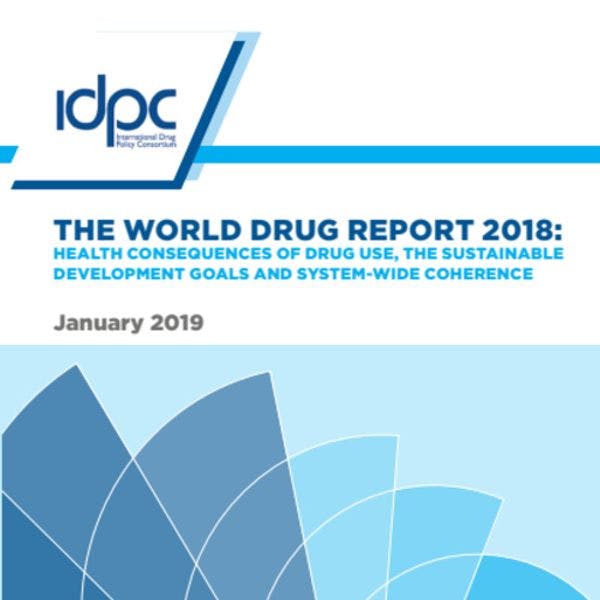IDPC analysis of the UNODC World Drug Report 2018
Almost a decade ago, the international community agreed upon a Political Declaration and Plan of Action on International Cooperation towards an Integrated and Balanced Strategy to Counter the World Drug Problem. The Declaration included the decision to establish 2019 as the target date for the goals set within it, specifically for states to ‘eliminate or reduce significantly and measurably’ the illicit cultivation, production, trafficking and use of internationally controlled substances, the diversion of precursors and money laundering. Consequently, despite the conclusion of a series of additional soft law instruments since 2009 – including the Outcome Document from the UN General Assembly Special Session on the ‘World Drug Problem’ in 2016 – we are fast approaching a critical juncture for the UN- based international drug control regime.
Having agreed the process at its 60th session, March 2019 will see the Commission on Narcotic Drugs (CND) convene a two-day Ministerial Segment to take stock of progress made and define a global drug strategy for the next ten years or so. While always important in helping to set the narrative for debates within the Commission, the publication of the World Drug Report 2018 comes at a particularly important moment, representing as it does the last major publication to come out of the United Nations Office on Drugs and Crime (UNODC or Office) before the high-level meeting. It is difficult to ignore the fact there remains no UN produced comprehensive review of the impacts of drug policies worldwide over the past decade to help inform the forthcoming discussion in Vienna, the home of the UN’s drug control apparatus. Moreover, that the Report fails to explicitly examine market trends since 2009 also appears to be a missed opportunity.
Nonetheless, as has been the case in recent years, the flagship publication remains rigorous in its analysis and provides an impressiveoverview of the latest developments and trends in the world’s illicit drug markets. Surely of significance for deliberations at the Ministerial Segment, the consistently high-quality research reveals a similar, if not more challenging, picture to previous years. Amidst the ongoing theme of uncertainty and issues around reliable and comprehensive data, readers learn of the increasing complexity and scale of the global drug market. As the UNODC’s Executive Director, Mr. Yury Fedotov, remarks in his preface, ‘Both the range of drugs and drug markets are expanding and diversifying as never before’ (1. p. 1). This view is echoed in the Report’s ‘Conclusions and Policy Implications’ section. Here the Office notes how ‘The information presented in the World Drug Report 2018 illustrates the unprecedented magnitude and complexity of the global drug markets’. ‘The adverse health consequences caused by drug use remains significant’, it continues, ‘drug related deaths are on the rise…’ (1, p. 23). And it is the adverse health consequences of drug use, particularly, although not exclusively those relating to injecting drug use, as well as policies and interventions designed and implemented to mitigate them, that will be the focus of this analysis.
Departing from the well-tried format of previous IDPC responses to, and analyses of, the World Drug Report, a series of publications dating back to 2006, our intention this year is to narrow our focus and explore just a few of the many facets of the ‘World Drug Problem’ to be found within the Office’s latest offering. Intending to supplement – in the absence of any UN level analysis – IDPC’s recent report, Taking stock: A decade of drug policy – A civil society shadow report (see Box 1), the pages that follow contain a discussion of not only the alarming scale of the negative health impacts of drug use described in the Report, but also the woefully inadequate provision of a range of scientifically proven interventions; interventions that operate comfortably within the existing confines of the three UN drug control treaties. Mindful of member states’ apparently increasing commitment to the 2030 Sustainable Development Agenda within the context of drug policy, a perspective notably incorporated within the 2016 UNGASS Outcome Document, we also make deliberate reference to the Sustainable Development Goals (SDGs) and the potential of the Agenda to improve progress towards the long soughtafter goal of UN system-wide coherence around drugs. A focus on the Report’s discussion of the complexities surrounding drug use patterns and treatment needs of specific groups – women, young people and old people – also reveals how conceptualisation of the intersection between the Goals and the issue of drug use can still be broadened. Indeed, as we suggest, in order to appropriately heed Mr. Fedotov’s call for the international community to ‘step up its responses to cope with’ the myriad ‘challenges’ explored in the Report, (1, p. 1), member states must resist the temptation of remaining in a Vienna bubble and connect drug policy more effectively to the broader goals of the UN system of which it is one small part.
Previous reports in this series:
- IDPC response to the 2017 World Drug Report
- IDPC response to the 2016 World Drug Report
- IDPC response to the 2015 World Drug Report
- IDPC response to the 2014 World Drug Report
- IDPC response to the 2013 World Drug Report
- IDPC response to the 2012 World Drug Report
- IDPC response to the 2011 World Drug Report
- IDPC response to the 2010 World Drug Report
- IDPC response to the 2009 World Drug Report
- IDPC response to the 2008 World Drug Report
- IDPC response to the 2007 World Drug Report
- IDPC response to the 2006 World Drug Report
Downloads
Topics
Regions
Related Profiles
- United Nations Office on Drugs and Crime (UNODC)
